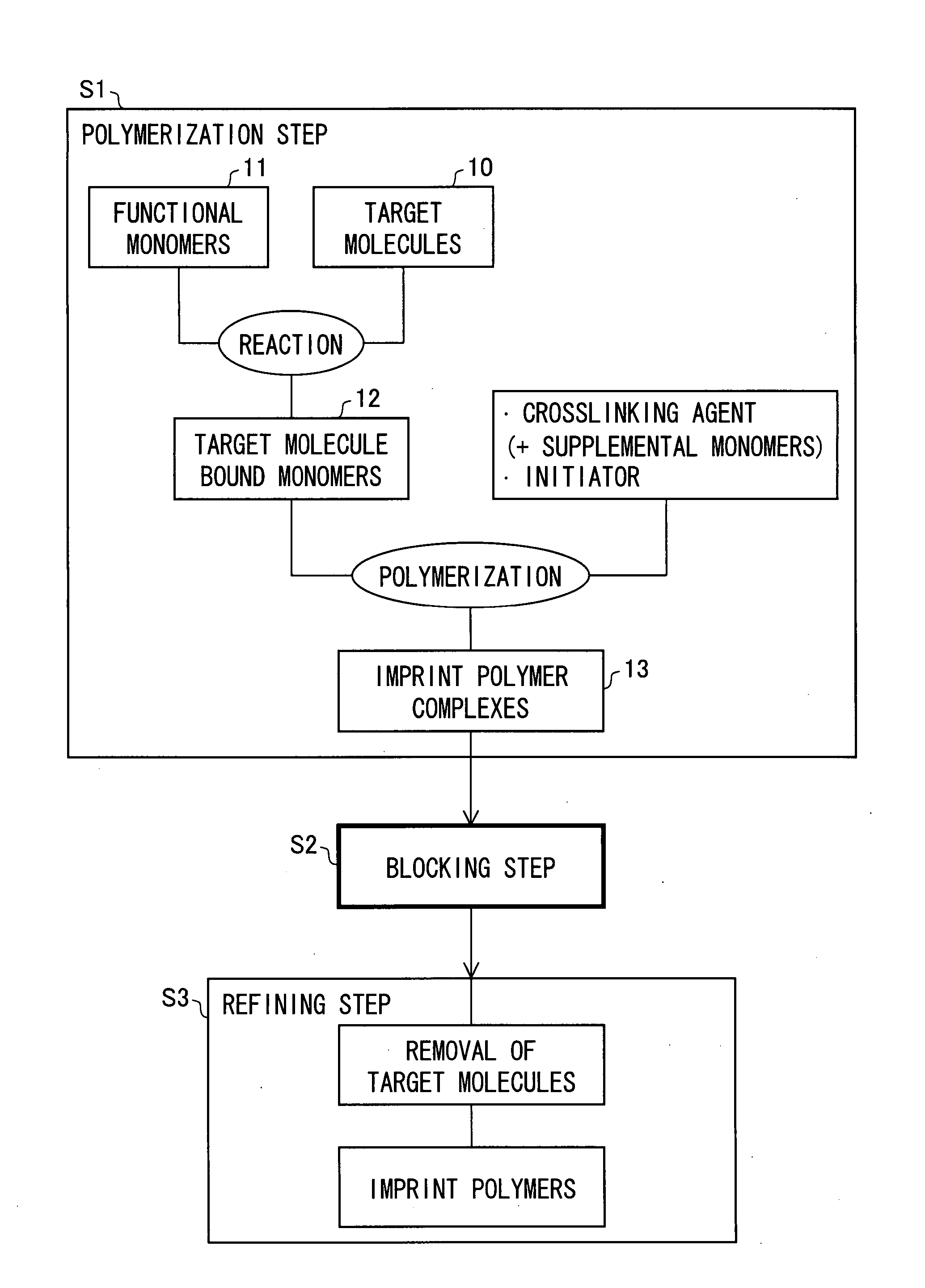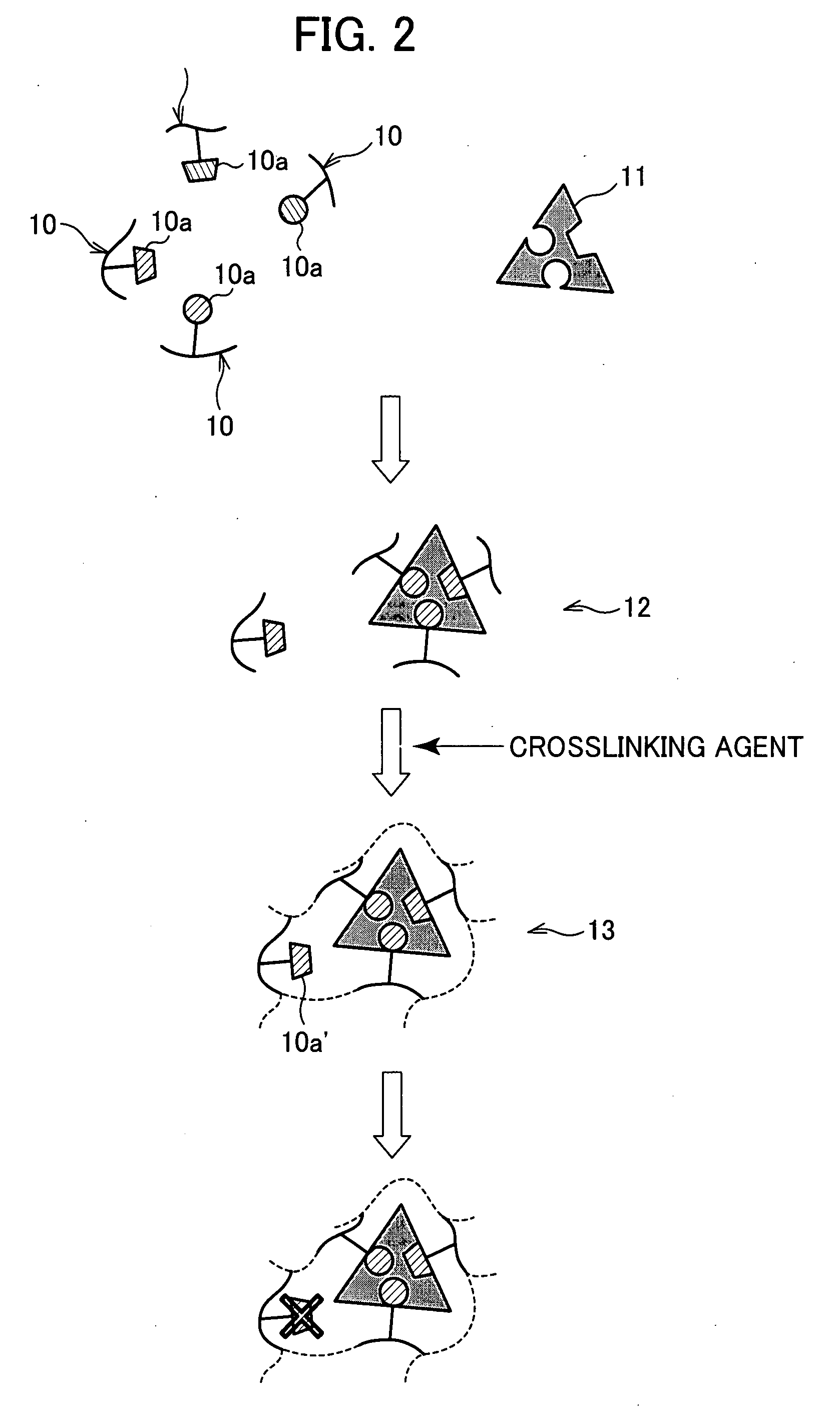Target molecule recognition polymer and method for producing the same
a target molecule and recognition polymer technology, applied in the field of target molecule recognition polymer, can solve the problems of poor selectivity, poor selectivity, and poor selectivity of non-patent document 1, and achieve the effect of high selectivity
- Summary
- Abstract
- Description
- Claims
- Application Information
AI Technical Summary
Benefits of technology
Problems solved by technology
Method used
Image
Examples
first embodiment
[0063] A production method of the present embodiment will be explained with reference to FIGS. 1 and 2.
[0064]FIG. 1 is a block diagram illustrating a MIP producing method which is one embodiment of the present invention. FIG. 2 is a view illustrating the state of a monomer or a polymer in a polymerization step in a production process illustrated in FIG. 1.
[0065] As illustrated in FIG. 1, a production method of the present embodiment includes: a polymerization step S1 of polymerizing a mixture of one or more target molecules and functional monomers having functional groups, which are able to interact with the target molecule, so as to form an MIP complex which the target molecules are interacted with and bound to; a blocking step (deactivation step) S2 of blocking (deactivating) a functional group which is not interacted with the target molecule in the MIP complex; and a refining step S3 of refining the MIP complex by removing the target molecules which are bound to the MIP complex...
second embodiment
[0087] The following will describe another embodiment of the present invention with reference to FIG. 3. Note that, for the purpose of explanation of differences from the First Embodiment, substances that are identical with those described in the First Embodiment are given the same reference numerals and explanations thereof are omitted here.
[0088]FIG. 3 is a block diagram illustrating a MIP producing method of the present embodiment. In the First Embodiment, the polymerization step S1 (FIG. 1) is followed by the blocking step S2. On the contrary, according to a producing method of the present embodiment, as illustrated in FIG. 3, a polymerization step S1 is followed by a cleaning step S4, and the cleaning step S4 is followed by a blocking step S2.
[0089] In the cleaning step S4, a polymerization reaction solution, which is used to form an MIP complex 13 in the polymerization step S1, is substituted for a suitable solution (hereinafter referred to as cleaning solution). This makes ...
third embodiment
[0095] The following will describe still another embodiment of the present invention with reference to FIG. 4. Note that, for the purpose of explanation of differences from the First Embodiment, substances that are identical with those described in the First Embodiment are given the same reference numerals and explanations thereof are omitted here.
[0096]FIG. 4 is a block diagram illustrating a MIP producing method of the present embodiment. In the First Embodiment, the polymerization step S1 is followed by the blocking step S2, as illustrated in FIG. 1. On the contrary, according to a producing method of the present embodiment, a polymerization step S1 is followed by a pretreatment step S5, and the pretreatment step S5 is followed by a blocking step S2, as illustrated in FIG. 4.
[0097] As illustrated in FIG. 2, a target molecule 11 has a plurality of functional groups, which interact with functional groups 10a of their respective functional monomers 10. However, in some cases, poly...
PUM
| Property | Measurement | Unit |
|---|---|---|
| Molar density | aaaaa | aaaaa |
| Acidity | aaaaa | aaaaa |
| Molality | aaaaa | aaaaa |
Abstract
Description
Claims
Application Information
 Login to View More
Login to View More - R&D
- Intellectual Property
- Life Sciences
- Materials
- Tech Scout
- Unparalleled Data Quality
- Higher Quality Content
- 60% Fewer Hallucinations
Browse by: Latest US Patents, China's latest patents, Technical Efficacy Thesaurus, Application Domain, Technology Topic, Popular Technical Reports.
© 2025 PatSnap. All rights reserved.Legal|Privacy policy|Modern Slavery Act Transparency Statement|Sitemap|About US| Contact US: help@patsnap.com



